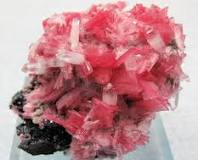
Rhodonite – The Healing Stone of Compassion and Inner Balance
Rhodonite, with its striking rose-pink background veined with deep manganese-black patterns, is a crystal beloved for its soothing yet strengthening energy. Revered for its ability to nurture the heart and instil emotional stability, Rhodonite offers both visual elegance and profound metaphysical depth, especially in its raw crystal jewellery form. As a balancing stone, it speaks to those seeking to restore harmony through self-love and compassionate action.

Geological Profile: Composition, Structure & Origins
Rhodonite is a manganese inosilicate mineral with the chemical formula (Mn,Fe,Mg,Ca)SiO₃, crystallising in the triclinic crystal system. Naturally forming in massive granular or compact habit, it can occasionally form tabular crystals, but more often appears as fleshy pink plates intersected by metallic black dendritic veins.
-
Hardness: 5.5–6.5 on the Mohs scale
-
Lustre: Vitreous to pearly
-
Colours: Mellow pink to deep rose, often streaked or mottled with dark manganese oxide
Notable Sources:
-
Australia – rich pink Rhodonite with full black veining
-
Sweden – historically prized for high-grade specimens
-
Russia (Ural Mountains) – famed source, often called “Siberian Rhodonite”
-
USA (New Jersey, Massachusetts) – source for American-style crystallised plates
-
Brazil, Canada, Mexico – modern commercial sources
Raw, veined Rhodonite slices and rough masses are favoured in mineral specimen necklaces and crystal specimen rings, as they preserve its natural elegance and emotive energy.
Energetic Meaning: Emotional Healing and Restoration
Rhodonite resonates strongly with the heart chakra, offering emotional compassion, courage, and forgiveness. Its nurturing frequency supports those in recovery—whether from heartbreak, trauma, or life transitions.
Core Energetic Themes:
-
Compassionate Healing: Alleviates emotional wounds and encourages self-forgiveness
-
Emotional Grounding: Helps calm panic, fear, and emotional confusion
-
Relationship Harmonising: Enhances empathy, communication, and connection
-
Self-Worth & Confidence: Encourages self-respect and understanding personal value
Worn as handmade gemstone rings, pendants, or earrings, Rhodonite serves as a compassionate ally, gently guiding the wearer toward heart-centred balance and clarity.
Raw Rhodonite: Finding Power in the Natural Form
While polished polished Rhodonite is popular, raw, veined specimens captivate with their organic authenticity. The black manganese patterns against pink stone evoke a sense of earth-rooted strength combined with gentle compassion.
Raw Rhodonite pieces offer:
-
Unique Visual Contrast – natural black veins against soft pink invite attention and conversation
-
Undisturbed Energy – many believe raw crystals preserve fuller vibrational integrity
-
Artisan Appeal – each raw piece contains unpredictable patterning, ideal for raw crystal jewellery
As a statement piece, raw Rhodonite may be wire-wrapped in minimalist style or set into a bezel that highlights its raw contours—each becoming a wearable heart-healing talisman.
Rhodonite vs. Similar Heart Stones: A Gentle Comparison
While Rhodonite is often grouped with other pink or heart-focused crystals like Rose Quartz or Rhodocrisite, it possesses distinct grounding properties. Where Rose Quartz offers gentle, unconditional love, Rhodonite introduces a firmer note of strength through healing. It is less ethereal and more action-oriented—ideal for turning emotional insight into transformative action.
Comparison Highlights:
-
Rhodonite vs. Rose Quartz: More structured and grounding; supports forgiveness and practical compassion
-
Rhodonite vs. Rhodocrisite: Rhodocrisite is more emotionally raw and high-frequency; Rhodonite steadies the heart with earthy resilience
-
Rhodonite vs. Garnet: Garnet energises and protects; Rhodonite calms and restores from within
This makes Rhodonite especially attractive in situations requiring personal recovery or relational reconciliation.
Rhodonite in Jewellery: The Rise of Specimen Adornment
In recent years, there has been a revival of interest in raw crystal jewellery, particularly among those who value authenticity and unique mineral forms. Rhodonite fits beautifully within this movement—not just as a gem, but as a mineral specimen with soul.
Jewellery Forms:
-
Crystal Specimen Rings: Showcase contrasting veins and vivid pink hues in chunky, sculptural settings
-
Mineral Specimen Necklaces: Often designed with organic, asymmetrical slabs or rough-cut slices
-
Handmade Gemstone Rings: Paired with oxidised silver or recycled gold for a modern, grounded aesthetic
Because of its physical softness compared to quartz or corundum, Rhodonite is best suited for pendants and rings with protective settings—and especially for pieces worn during restorative or ceremonial moments.

Cultural and Mythic Echoes
Historically, Rhodonite was highly prized in Russia, where it was once considered a national stone. In the 18th and 19th centuries, Russian aristocrats crafted Rhodonite into grand tombstones, columns, and ornaments—believing it held protective properties for the soul after death. In folklore, Rhodonite was also thought to protect travellers and encourage mutual understanding between strangers.
The name “Rhodonite” comes from the Greek rhodon, meaning “rose,” affirming its enduring symbolism of emotional tenderness and beauty.
Final Thoughts: A Crystal of Realistic Grace
Unlike many heart-centred crystals that float in soft emotion, Rhodonite is grounding, honest, and transformative. It speaks to those ready to heal the past and grow from it. Its bold veining reminds us that scars are not flaws, but maps of our resilience.
At Oryssia, we see Rhodonite not merely as jewellery material, but as an emotional artefact—honouring both the Earth’s mineral legacy and our personal evolution. When worn as a raw crystal ring or specimen necklace, Rhodonite becomes a mirror of grace, strength, and emotional maturity.